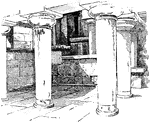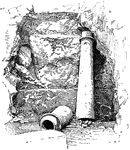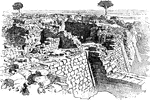Clipart tagged: ‘greek architecture’
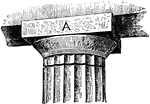
Abacus
"In architecture the slab or plinth which forms the upper member of the capital of a column or pillar,…

Acanthus Leaf, Front and Side Views
The acanthus is one of the most common ornaments used to depict foliage.
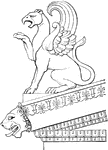
Acroteria from the Temple of Minerva at Ægina
On the apex and two lower angles of the pediment were introduced acroteria, sometimes ornaments of flowers…
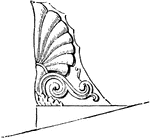
Acroteria, or Roof-Pedestal, from the Temple of Theseus at Athens
On the apex and two lower angles of the pediment were introduced acroteria, sometimes ornaments of flowers…
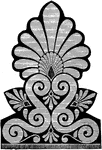
Ante-fixae
Ante-fixae (from Latin antefigere, to fasten before), the vertical blocks which terminate the covering…
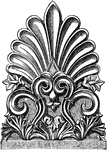
Ante-fixae
Ante-fixae, the vertical blocks which terminate the covering tiles of the roof of a Roman, Etruscan,…

Double Twist on an Astragal
An astragal is molding profile composed of a half round surface surrounded by two flat planes (fillets).…
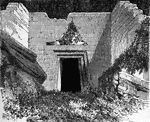
Tomb of Atreus
The Tomb of Atreus also known as the Treasury of Atreus is a tomb located in Mycenae, Greece built between…
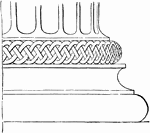
Attic Base in the Temple of Minerva Polias
The so-called Attic base is the form which most frequently occurs; and consists of two tori separated…
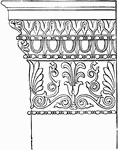
Ionic Antæ Capital from the Temple of Minerva Polias at Athens
The capital of the antæ and pilasters is without volutes, as is seen here. The shaft has no flutings;…
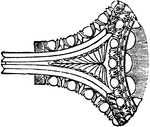
Plan of Ionic Antæ Capital from the Temple of Minerva Polias at Athens
The capital of the antæ and pilasters is without volutes, as is seen here. The shaft has no flutings;…
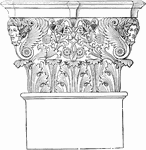
Corinthian Capital
The structural tendency which prevails in the capitals of all orders to change from the circular form…
Caryatis from the Erechtheum at Athens
Caryatides are a blending of architecture and sculpture, but they are not of frequent occurrence. These…
Profile of the Caryatis with Pedestal and Entablature
Caryatides are a blending of architecture and sculpture, but they are not of frequent occurrence. These…
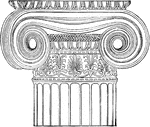
Ionic Angle Column from the Temple of Minerva Polias at Athens, Front
The good effect of the Ionic capital is really only produced by the front-view. It seems calculated…

Ionic Angle Column from the Temple of Minerva Polias at Athens, Side
The good effect of the Ionic capital is really only produced by the front-view. It seems calculated…

Doric Column from the Temple of Neptune at Paestum
The Doric columns, which are short, powerful, and closely ranged together, in order to support the weight…
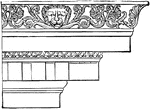
Ionic Cornice from the Temple of Minerva Polias at Priene
The entablature resting on the columns has three parts: a plain architrave divided into two, or more…
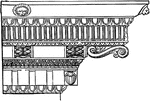
Corinthian Cornice
The Corinthian cornice is only distinguished from the Ionic by its mutules and modillions, which take…

Egg-and-Dart
Egg-and-dart is an ornamental device often carved in wood, stone, or plaster quarter-round ovolo mouldings,…
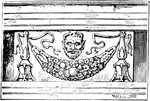
Encarpus
"In architecture, a sculptured ornament in imitation of a garland or festoon of fruits, leaves, or flowers,…
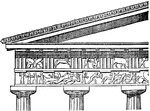
Doric Entablature
"Doric Entablature. E, entablature: a, epistyle or architrave; b, frieze; c, cornice." -Whitney, 1911

Erechtheum
"The 'house of Erechtheus'; a temple of Ionic order on the Acropolis of Athens, noted as one of the…

Erechtheum with the Pandrosium
Belonging to the time directly after Pericles is the Erechtheum. This is a double temple in the Ionic…
Exedra at the Street of Tombs in Assos
An exedra is a semicircular recess set into a building's facade. The exedra at the Street of Tombs in…
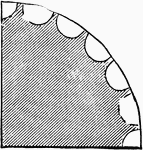
Fluting Plan of the Ionic and Corinthian Column
The Ionic column has a less diminished shaft and a smaller parabolic curve than the Doric. It is, like…

Doric Order Frieze in the Parthenon at Athens
The frieze of the Doric order is not taken up with sculpture in uninterrupted succession, but it occurs…
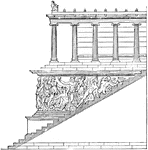
Frieze of Altar at Pergamon
The stairway of the great altar at Pergamon in Ancient Greece shows a frieze. A frieze is a sculpture…
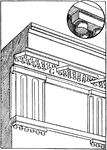
Gutta in Doric Architecture
"Guttae in Doric Architecture. A, form of gutta beneath regula; G, G, guttae beneath mutules and regulae.…

Hittite Masonry Walls
"The ancient capital of the Hittites in Central Asia Minor recently excavated." -Breasted, 1914
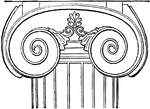
Ionic Capital from the Temple of Apollo at Basse
In the capital the Doric echinus is replaced either by a cyma ornamented with leaves, or, more generally,…
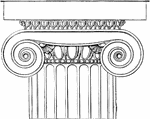
Ionic Capital from the Temple of Minerva Polias at Priene
In the capital the Doric echinus is replaced either by a cyma ornamented with leaves, or, more generally,…

Side View of the Ionic Capital from the Temple of Minerva Polias at Priene
These volutes, or scrolls, when viewed from the side, appear to meet in the middle, and form a wavy…
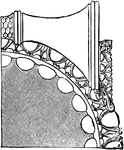
Top View of the Ionic Capital from the Temple of Minerva Polias at Priene
These volutes, or scrolls, when viewed from the side, appear to meet in the middle, and form a wavy…

Gate of the Lions
The Gate of the Lions is located in Mycenae, Greece. It was the entrance to the city. On top of the…

Echinus Molding
"A Capital of the Parthenon. - E, Echinus. In architecture, the convex projecting molding of eccentric…

Choragic Monument of Lysicrates
Of a less ambitious class were those monuments erected in honor of the victorious choragus in musical…
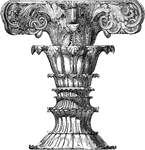
Finial of the Choragic Monument of Lysicrates
Of a less ambitious class were those monuments erected in honor of the victorious choragus in musical…

Mutule, Front View
Rectangular block under the soffit of the cornice of the Greek Doric temple, which is studded with guttae.…

Mutule, Side View
Rectangular block under the soffit of the cornice of the Greek Doric temple, which is studded with guttae.…

Temple of Neptune
The Temple of Neptune is located in the Graeco-Roman ancient city of Paestum, located in the Campania…
Ionic Pillar in the Erechtheum at Athens
The Ionic order was indebted for its earlier development to western Asiatic influence, notably to that…
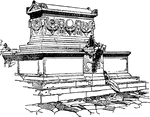
Sarcophagus
"Sarcophagus from the Street of Tombs at Assos in the Troad, excavated by the Archaeological Institute…

The Parthenon
The Parthenon is a temple of the Greek Goddess Athena, who was considered as the protector of the city…
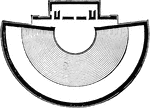
Ground Plan of the Theatre at Iassus
The theatres were originally built on a very large scale to accommodate the large number of people on…
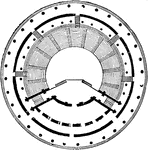
Ground Plan of the Theatre of Herodes Atticus
The Odeon of Herodes Atticus is a stone theatre structure located on the south slope of the Acropolis…

Façade Tile from the Temple of Diana at Ephesus
On the apex and two lower angles of the pediment were introduced acroteria, sometimes ornaments of flowers…

Section of a Volute of an Ionic Capital
These volutes, or scrolls, when viewed from the side, appear to meet in the middle, and form a wavy…

